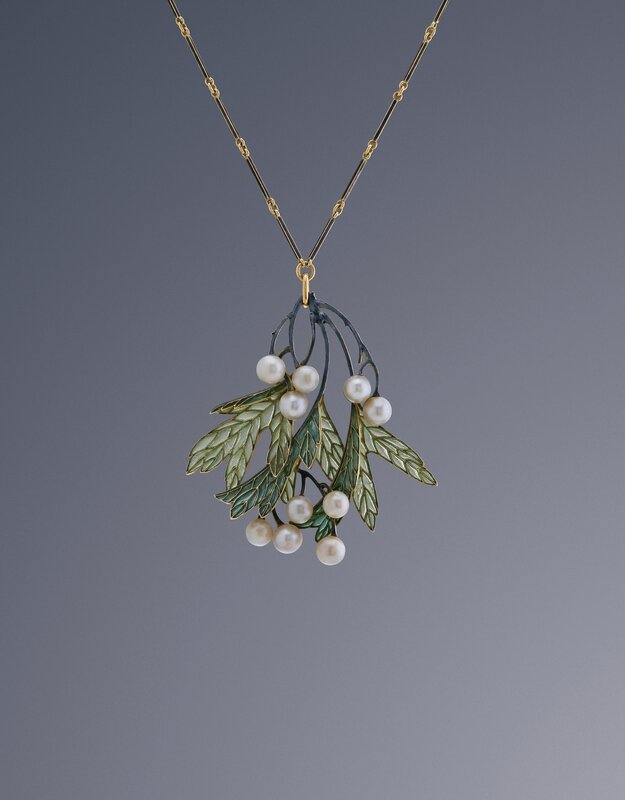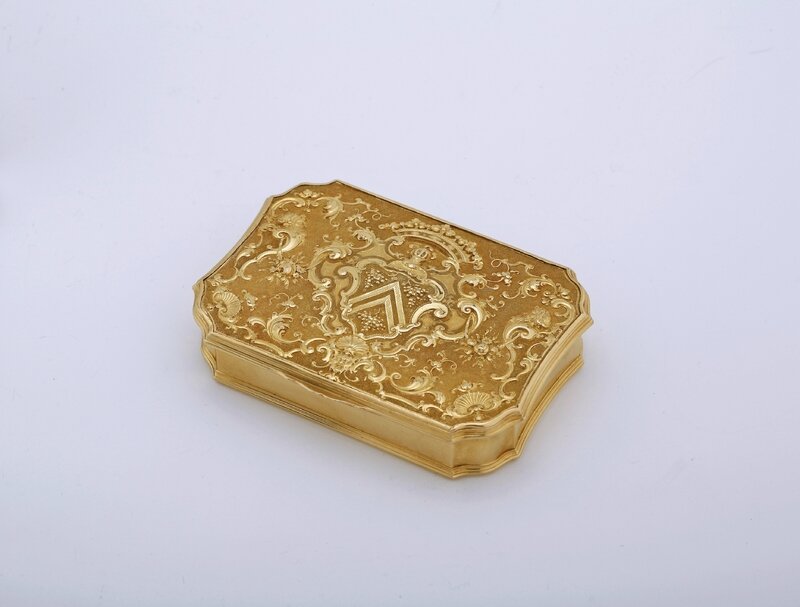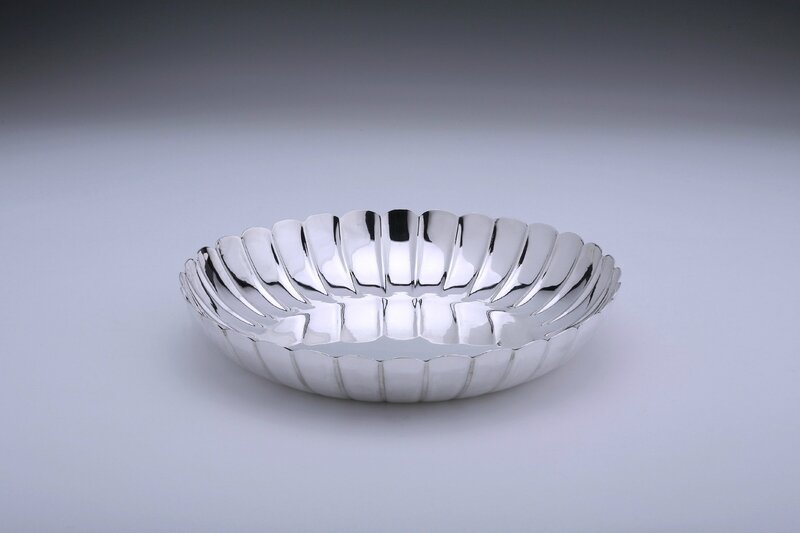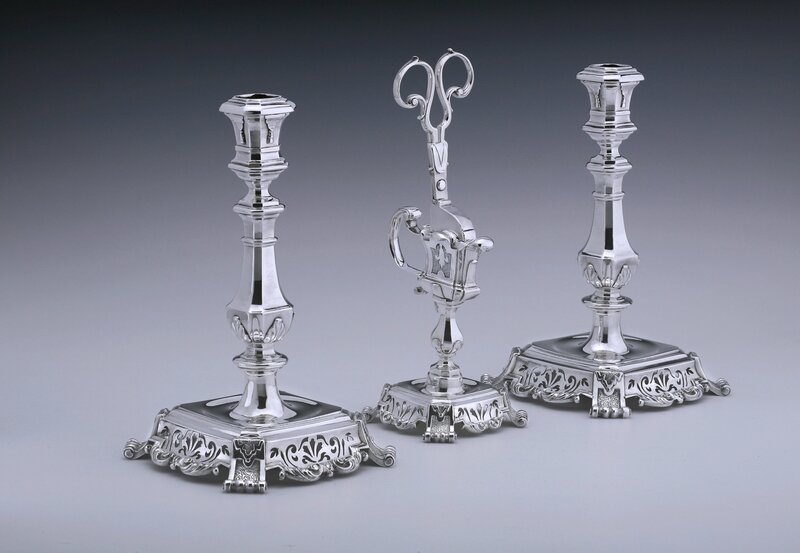A. Aardewerk Dutch Silver and Antique Jewels at TEFAF New York Fall 2017
René Lalique (Ay 1860-1945 Paris), Pendant, Paris 1901. Gold, enamel and pearls. Height of pendant 6 cm. Signed 'Lalique' and stamped with maker’s mark. © A. Aardewerk Dutch Silver and Antique Jewels
The beautiful plique-à-jour enamelled leaves of this pendant “sorbus suecica" or Swedish Whitebeam curl around the pearl berries and the mauve enameled twigs. The original gold chain also has dark mauve enameled links. This elegant pendant was made by René Lalique, the leading innovator on French Jewellery in the late nineteenth century and one of the driving forces behind the development of Art Nouveau in France. Lalique developed a completely original style, drawing inspiration from both nature and Japanese art. This signed and dated pendant, of which the design drawings are known, is a refined example of his work.
Provenance: Private collection, The Netherlands.
Literature: Dr. Sigrid Barten, René Lalique, Schmuck und Objets d’art 1890-1910, 1989, ill. 644 on p. 320; O. Coutau-Bégarie, René Lalique, dessins originaux, vente de jeudi 20 Octobre 1994, lot 40 on p. 8; Catalogue Uit de kunst, 100 years VHOK, 2011, ill. 108 on p. 152; Catalogue René Lalique, Master of French Art Nouveau and Art Deco, 2013, ill on p. 48.
Exhibition: Apeldoorn, Museum Paleis het Loo, 2011; The Hague, Municipal Museum, 2013.
Jean Saint, The Van Eys Snuffbox, Amsterdam, 1732. Gold. © A. Aardewerk Dutch Silver and Antique Jewels
The rectangular box has curved corners and the lid is decorated with the arms of Jan Nicolaas van Eys. The coat of arms and the helm and crown above it are chased amid a strictly symmetrical design of C-scrolls, scallop shells, strapwork and mascarons against a textured background.
Solid gold Dutch snuffboxes are rare. This example is one of the earliest and also one of the few executed wholly in Louis XIV style. Most Dutch gold snuffboxes were made in the Rococo style. In the eighteenth century, almost every well-to-do man would carry a snuffbox. Tobacco was smoked and chewed, but it was also ground to a fine powder and inhaled, to invigorating effect. Snuff was kept in jars, but carried in small quantities for daily use in little boxes that rapidly became a status symbol. The more expensive the snuffbox, the greater the impression its owner could make. Jan Nicolaas van Eys (1691-1758) was a cloth merchant and a prominent member of Amsterdam society. In 1740 he was director of the Levant trade. From 1748 to 1758 he sat on the Council of Amsterdam and from 1753 to 1768 he was one of the commissioners for maritime affairs.
Provenance: Collection of Elisabeth Rohde (1915-2013), director of the Pergamon Museum in 1971; she inherited the box from her father Kurt Rohde (1882-1950); this former major had run the Kurt Rohde gallery with Frieda Hinze in Uhlandstrasse, Charlottenburg, Germany, since 1918.
Adriaan Havelaar, Strawberry dish, The Hague, 1718. Silver, Diameter 21.6 cm (8.5 in.). © A. Aardewerk Dutch Silver and Antique Jewels
The strawberry dish is round with a curved rim divided into large lobes by chased lines. The understated design gives the dish a timeless air and creates a beautiful effect of light. It is a fine example of almost three-hundred-year-old design. The oldest known silver strawberry dish was made in London in 1699. This example, is one of the earliest known Dutch strawberry dishes and also one of the largest.
Reinier Brandt, A large bread basket, Amsterdam, 1767. Silver. © A. Aardewerk Dutch Silver and Antique Jewels
This basket is one of the largest made by Reinier Brandt, a highly skilled and productive maker of tableware who had made baskets one of his specialities. His skill in spacing the ornamentation on the sloping walls evenly and creating the finest of openwork was unrivalled. Without compromising the strength of the basket, he created an extraordinarily delicate decoration of flowers and vines
The first silver baskets appeared in the Netherlands around 1747. The oval model with the slightly curved upstanding body is typically Dutch. In eighteenth-century inventories, large baskets like this are described as bread baskets. The only other place in Europe where silver baskets were made was England, but the English variants are rounder and have a hinged handle rather than an integral handle at each end.
The base and side walls of the basket were chased from a single sheet of silver. The upper rim and lower edge, cast in sections, were soldered on. The decoration was then engraved around the basket and only then was the design sawn out. The ornaments on this basket form an elegant whole. The rim and the border of the base are constructed from cast C-shaped ornaments with a variety of cast clusters of fruit between them. The two handles are also decorated with cast flowers and fruit. The side walls are pierced and engraved all round in Louis XV style with flowers, fruit and ears of wheat. Many of them have a symbolic meaning and suggest fertility, growth and vitality, as well as prosperity, wealth and success.
Provenance: Private collection, Netherlands
Literature: J. W. Frederiks, Dutch Silver, vol II, p. 103 no. 298 fig. 114; A.L. den Blauwen, Nederlands Zilver, 1979, p. 284 no. 137; K.A. Citroen et al., Meesterwerken in Zilver, 1984, p. 143 cat. no. 165 and p. 205; J. Verbeek, Nederlands Zilver, 1988 p. 70 fig. 85; J. R. de Lorm, Amsterdams Goud en Zilver, 1999, p. 150 cat. no. 87.
Royal Van Kempen, Begeer & Vos, Rivière necklace, Voorschoten, 1920-31. Old European cut diamonds, silver, gold, sixty-seven brilliants and two pear-shaped diamonds, circa sixty-two carats. © A. Aardewerk Dutch Silver and Antique Jewels
This necklace is fully set with old European cut diamonds in silver on gold settings. It contains sixty-seven brilliants and two pear-shaped diamonds, weighing around sixty-two carats altogether. The necklace comes to pieces from which two bracelets can be made. One bracelet is made up of the diamonds in the front part of the necklace, including the pear-shaped diamonds, weighing 31.3 carats. The two sections on either side also make a bracelet, with slightly smaller diamonds, twenty-four carats in total. The piece at the centre back is an extension piece to adjust the length of the necklace.
The official name for a necklace like this is a Rivière. The term denotes a necklace made of diamonds or other precious stones that decrease gradually in size from the largest central stone at the front. Rivières were always part of formal dress and were worn by the highest of the elite in the evening and at official events. The more important the wearer, the larger the diamonds or the more numerous the rivières.
Provenance: The necklace is in the original case supplied by jewellers J. C. Burnier & Zoon in The Hague. The blue velvet case is stamped with initials in gold: C. d. H d. I. v. It belonged to Baroness d’Hangest d’Ivoy, who married W.J van Lynden in 1911, and has been in the family ever since.
Carl Bacher, An Egyptian Revival Bangle, Circa 1870. 14-carat-gold, opals, diamonds, green and white enamel in cloisonné bars and rubies. Marked with the maker’s mark of Carl Bacher, 'CB' in an oval. © A. Aardewerk Dutch Silver and Antique Jewels
The terminals of this sophisticated, elegant 14-carat-gold bangle are in the shape of scarabs carved from opals and set with diamonds. They are set in a gold mount to which a gold bead is attached. The opals are held in stylized red enamel lotus motifs. Behind them is a band of green and white enamel in cloisonné bars; the refined granulation is further accentuated by a band set with rubies.
François Lambregts (1696-Amsterdam-1751), Kettle on stand. Dutch. Silver in Louis XIV style. © A. Aardewerk Dutch Silver and Antique Jewels
The round, pear-shaped kettle in Lambregts’s is completely smooth with a slightly flattened body. The kettle is decorated around the neck and on the body with cast and applied ornaments of friezes and fleur-de-lis motifs. The tall lid is decorated with cast and applied lily-shaped ornaments around the beautifully executed knob. The high hinged handle is composed of C-scrolls. The spout is also elaborately decorated with foliar motifs.
The kettle stands on a tall stand with a spirit stove. The walls of this stand have openwork all round in a symmetrical pattern in Louis XIV style. The stove stands on three decorated C-shaped feet and has two hinged handles. These ornaments, which originated at Louis XIV’s court, were disseminated in the Low Countries in model drawings by great designers like Daniel Marot.
Provenance: Collection Joseph M. Morpurgo 1962; private collection, Switzerland; Sotheby's Geneva 1997; private collection, Belgium.
Literature: Catalogue Oude Kunst en Antiekbeurs Delft 1962; Frederiks, Dutch Silver, vol. II, plate 267, p. 93; Nederlands zilver, 1979 cat. no, 112.
Exhibition: Delft, Oude Kunst en Antiekbeurs, 1962; Amsterdam, Rijksmuseum, Nederlands Zilver, 1979; Toledo, The Toledo Museum of Art, Dutch Silver, 1980; Boston, Museum of Fine Arts, Dutch Silver, 1980.
François Lambregts (1696-Amsterdam-1751), A set of candlesticks with a pair of Snuffers on stand, Amsterdam, 1726. Silver. © A. Aardewerk Dutch Silver and Antique Jewels
The candlesticks stand on gently scrolled feet with patterns on a textured surface. The snuffers sit on a stand with the same decoration. The handles of the snuffers are elegantly formed of C-scroll ornaments. The rectangular holder for the snuffers has moulded corners. There is a large fleur-de-lis ornament on a matt background on the long sides. Fully marked on the underside of the foot with the assay mark for Amsterdam, the Dutch lion, the maker’s mark FL for François Lambregts and the date letter Q for 1726.
Provenance: A. Aardewerk antiquair juwelier 1973; thereafter private collection, The Netherlands.
A. Aardewerk is a family-owned company specializing in superb quality antique Dutch silver dating from the sixteenth century onwards and in fine antique and period jewels. Emiel and Esther, who were raised with antiques, joined their father in the business in 1995. They are the fourth generation of antiques experts in the family and the directors of the company which is based in The Hague in the Netherlands. A. Aardewerk has been exhibiting at the renowned international TEFAF Art and Antiques Fair in Maastricht since 1995, and has been participating in the PAN Amsterdam Fair since 1993. A. Aardewerk is a member of The Royal Association of Fine Art Dealers in the Netherlands (Koninklijke Vereeniging van Handelaren in Oude Kunst) and of CINOA (Confédération Internationale des Négociants en Oeuvres d’Art).
A. Aardewerk Dutch Silver and Antique Jewels at TEFAF New York Fall 2017, Stand 54. Primary Address: Jan van Nassaustraat 76, The Hague, Netherlands. T +31703240987 - silver@aardewerk.com - www.aardewerk.com

/https%3A%2F%2Fprofilepics.canalblog.com%2Fprofilepics%2F1%2F0%2F100183.jpg)
/https%3A%2F%2Fstorage.canalblog.com%2F03%2F02%2F119589%2F96711876_o.jpg)
/https%3A%2F%2Fstorage.canalblog.com%2F11%2F31%2F119589%2F94773502_o.jpg)
/https%3A%2F%2Fstorage.canalblog.com%2F20%2F83%2F119589%2F94772815_o.jpg)
/https%3A%2F%2Fstorage.canalblog.com%2F26%2F72%2F119589%2F75604929_o.jpg)
/https%3A%2F%2Fstorage.canalblog.com%2F59%2F60%2F119589%2F26458628_o.jpg)










/http%3A%2F%2Fstorage.canalblog.com%2F25%2F73%2F119589%2F122439206_o.jpg)
/http%3A%2F%2Fstorage.canalblog.com%2F83%2F29%2F119589%2F112368855_o.jpg)
/http%3A%2F%2Fstorage.canalblog.com%2F36%2F10%2F119589%2F112131599_o.jpg)
/http%3A%2F%2Fstorage.canalblog.com%2F16%2F92%2F119589%2F112131345_o.jpg)